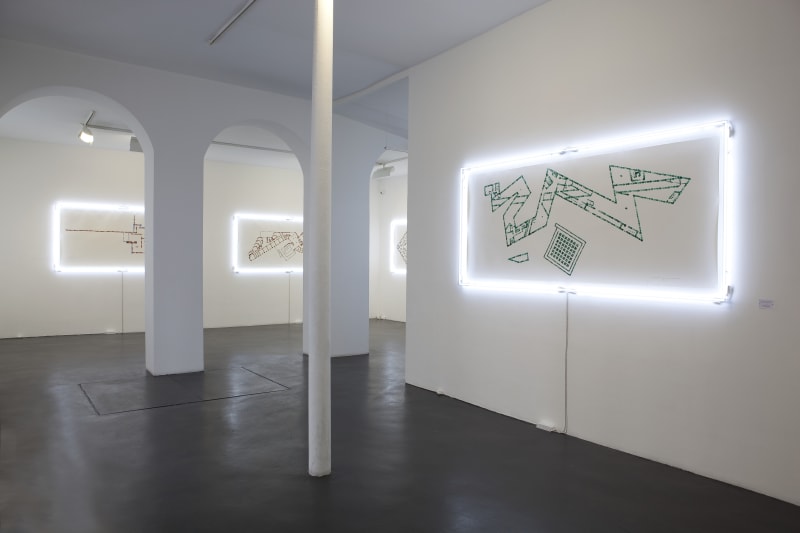Galerie Nathalie Obadia is delighted to present its first exhibition of works by Sarkis, one of the most influential artists on the contemporary art scene.
This solo show entitled Opus 2 extends the questioning of architectural sites and art space begun a year ago in Opus, the solo show organised a year ago at Galerist, Istanbul.
Under this title Sarkis brings together architectural plans which he performs as if they were musical scores, placing his work under the twin signs of architecture and music and thereby reactivating the quest for a total artwork.
This new exhibition gathers together some fifteen works by Sarkis, most of them never previously shown. Mirrors on easels constellated with fingerprints painted in watercolour and lit by stained glass panels placed opposite will accompany a series of architectural plans surrounded by neons, reviving a pictorial vocabulary that has informed the artist's work ever since the 1980s.
The selection of plans interpreted by the artist- Alhambra Interpretation Opus n°1, Gaudi Interpretation Opus n°1, Rohe Interpretation Opus n°1… - retraces the history of modernity, while the abstract nature of the architectural drawings serves the artist as a matrix, one that he fills with his colours and marks, which tactile signatures underscore the physical properties of the support. The neon letters restore the works' lost aura, inspiring meditative silence in the beholder (Calme) or projecting the work into the possibility of writing a memory, with the apparently mysterious inscription "19380" referring to Sarkis's own life by putting a zero after the year of his birth.
The Ariane's thread through what is a labyrinthine output, fingerprints constitute the leitmotiv of this set of works steeped in musical culture -- Aquarelles, Ikones, the stained glass of Silvacane Abbey - up to the Opus series, which opens "new spaces of meaning while placing itself within the continuity of a motif."[1] The artist's mark applied to glass or paper brings into play the fundamentals of matter: water, fire, air and light, showing a body in the process of formation, art in the making - the "co-birth of the world and the self," as Paul Claudel put it.
"The mark makes it possible to set a scale for a liquid expanse of colour on paper, a personal scale," explained Sarkis in a text accompanying the production of his stained glass windows at Silvacane Abbey in 2001, one of the prototypes for which is part of Opus 2.
A text by the Turkish art critic Aykut Köksal about the "Semantic Levels of Sarkis's Opus" accompanies the show.

